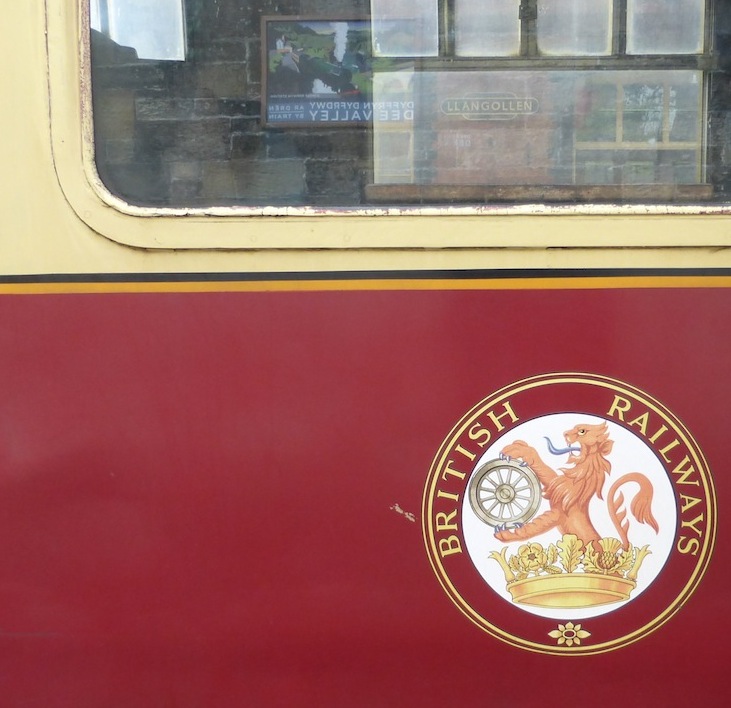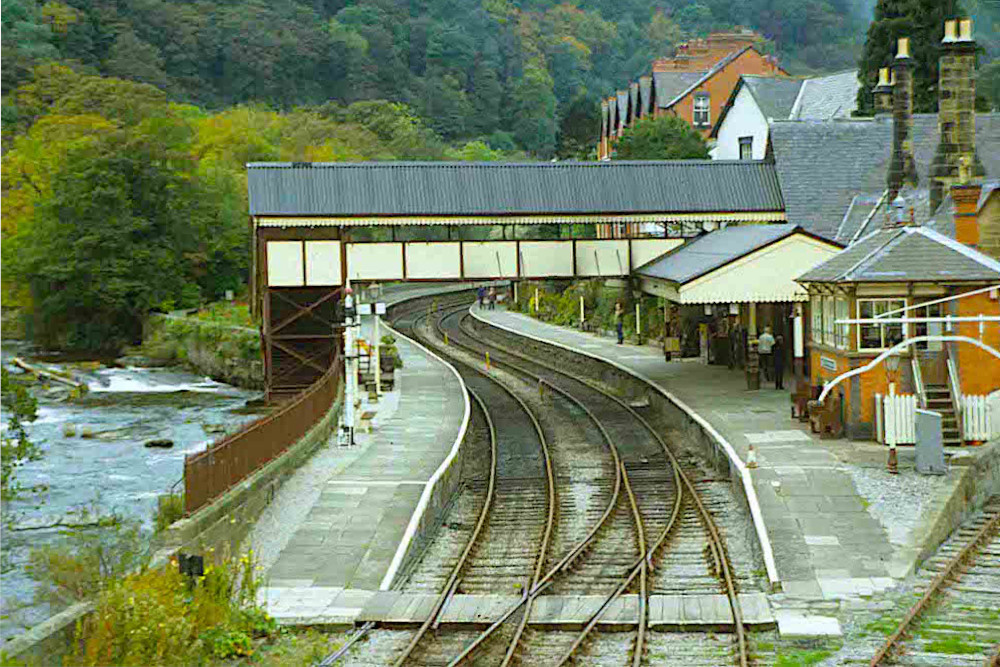Photographs by the author, except for the last, which is by Colin Price.You may use them without prior permission for any scholarly or educational purpose as long as you (1) credit the photographer and (2) link your document to this URL in a web document or cite The Victorian Web in a print one. Click on the images to enlarge them.

Llangollen Station from above. The station is in the heart of a beautiful area of North Wales, in the valley of the River Dee, and near the bridge on the main road, making it easy to look down on the whole station complex. The railway was proposed by the Great Western Railway (GWR): construction began in 1859, and the railway opened in 1861. In 1895 it was still deemed "semi-independent" (Sekon 323), but in the following year it was officially amalgamated with the Great Western Railway ("The Llangollen Railway's History"). Later, however, it fell victim to the swingeing cuts of the 1960s. Thanks to the hard work of the Llangollen Railway Trust, it was reopened in 1984. The trust tells us on its website that it is "the only standard-gauge heritage railway in North Wales," and at present travels ten miles to the small market town of Corwen, which the trust describes as "the cross roads of North Wales."



Left to right: (a) Signboard outside the station. (b) The station building. (c) The well-preserved booking hall.
Llangollen, as the timetable brochure informs us, "is the main hub of the railway." Various parts of the complex (the station building itself, the up and down "excursion" platforms, the footbridge etc.) are all separately Grade II listed. The present Tudor Revival railway building dates from 1865, when it was constructed by Thomas Brassey, under the direction of railway engineer Henry Robertson (see "Railway Station"). This was a tourist draw from the start. Jim Green reminds us that the Gladstones "chose to visit the area when touring by barouche and stayed at the village of Llandegla. north of Llangollen, at the Crown Inn" (31).



Left to right: (a) On the departure platform, ready to go to Corwen. (b) The British Railways logo with its commanding British lion. (c) Locomotive no. 3802, which was built in 1938/9.
Since this is a standard-gauge line, everything, including the livery of the engine and carriages, "is a reminder of steam-hauled British Rail in the days before the car became the supreme form of transport and dealt the death blow to rural rail lines in the 60s" (Green 31). Locomotive 3802, shown above, is a Great Western Rail locomotive built at the Swindon works and completed in 1939 ("UK Locos").



(a) A later British Railways logo on the carriages. (b) The identity number on the carriages, BR M858. (c) Pulling out of the station.
Green writes, rather amusingly, that although "the brass and paintwork of the engines shine much more than they ever did in the hardworking heyday of steam rail .. the carriages have an air of "cared for but much-used shabbiness that is entirely authentic" (32). However, the ones shown here are not Victorian: the BR 4858 Mark 1 Tourist Second Open was built 1960 ("BR 4858").

An endearing feature of the railway, as Colin Price points out and demonstrates in this photograph, is the way the tracks follow the meandering path of the Dee.
Related Material
Bibliography
"BR 4858...." Vintage Carriages Trust. Web. 4 July 2017.
Green, Jim. Welsh Railways. Talybont, Ceridigion: 2001.
"The Llangollen Railway's History." Llangollen Railway. Web. 4 July 2017.
"Railway Station (Main Building & Footbridge), Llangollen, Denbighshire." British Listed Buildings. Web. 4 July 2017.
Sekon, G. A. A History of the Great Western Railway: Being the Story of the Broad Gauge. 2nd ed. London: Digby, Long & Co., 1895. Internet Archive. Contributed by University of California Libraries. Web. 4 July 2017.
Simmons, Jack. The Victorian Railway. Pbk ed. London: Thames and Hudson, 1995.
"UKLocos Record No. 1106." UKLocos. Web. 4 July 2017.
"Welcome to Llangollen Railway." Llangollen Railway. Web. 4 July 2017.
Last photograph and caption added 21 June 2020